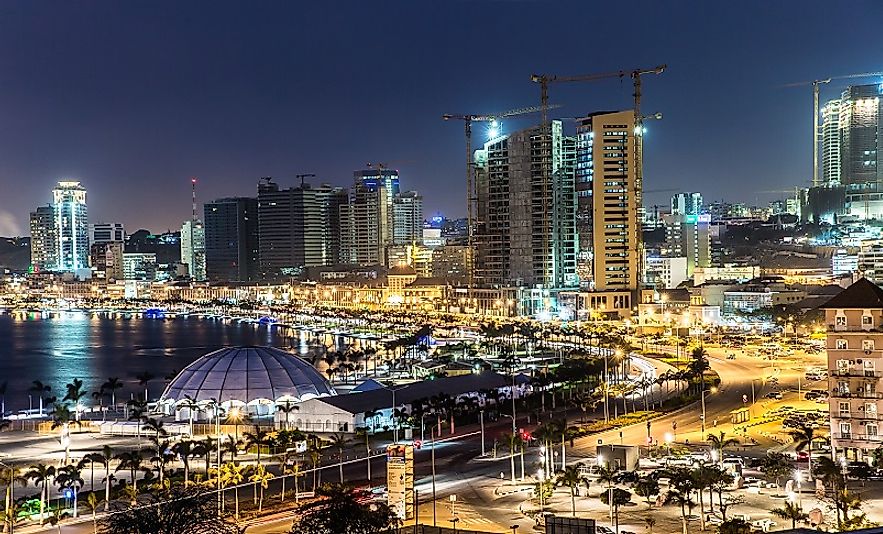Biggest Cities In Angola

Luanda is Angola’s capital, and is also by far the largest city in the country with more than 6 million residents. The oil producing country of Angola is located in Southern Africa and borders the Democratic Republic of Congo, Zambia, and Namibia. Blessed with abundant resources and suitably located near the coast or along major infrastructure, Angola’s cities have witnessed increasing urban growth.
Luanda
6,542,942 inhabitants live in the Angolan capital city of Luanda. The port city of Luanda stretches along the Atlantic Coast and it is the political, economic, and administrative center of Angola. Founded in 1575, Luanda developed extensively as an administrative center of the Portuguese. Luanda was an important slave trade center, particularly for the slaves bound for Brazil. Luanda experienced a brief decline after the abolishing of slavery but achieved economic significance as a port from the trade of commodities such as palm oil, cocoa, coffee, timber, and ivory. Supply of fresh water to the city and the thriving of introduced crops such as cassava and maize further increased the prosperity of the city. The city was however severely damaged by the civil war starting 1975. Current peace and stability have fueled economic growth in the recent years. The Angolan government has undertaken measures to reconstruct the city through modern infrastructure and housing. Slums and dilapidated buildings are some of the challenges to the modernization efforts. Blessed with abundant natural resources such as oil and diamonds, Luanda has recently been on an upward trajectory regarding development. Overcrowding, congestion and traffic jams are a common phenomenon in Luanda. The city is increasingly attracting foreign expatriates, mainly due to the oil boom. This situation has resulted in numerous luxury developments such as gated communities and hotels. Luanda has continuously been named as the most expensive city for expatriates, as a majority of its population continues to live in poverty.
Huambo
Huambo city is home to 1,896,147 inhabitants, making it the second largest city in Angola. The city was founded in 1912 by Portuguese workers and settlers along the Benguela Railway. The Benguela railway, having recently been rebuilt by the Chinese, is linked to the port of Lobito along the Atlantic Coast and the Angola’s neighbors of the Democratic Republic of Congo and Zambia. The Benguela Railway propelled Huambo to prosperity as a transportation center and farm produce such as wheat and coffee also contributed to the growth of the city. Huambo was however damaged by the civil war, the effects of which are visible in the modern day. Land mines buried in the countryside, for example, have inhabited farming in some regions. Recent developments such as the reconstruction of the Benguela Railway, a power plant coupled with a favorable climate have been attracting a stream of investors to the area. The city’s inhabitants, mostly the Ovimbundu ethnicity mainly engage in agriculture. The city has a high poverty rate, however, and the city’s potential tourism and abundant natural resources are being tapped to reverse the poverty statistics.
Lobito
The third largest Angolan city, Lobito has a population of 324,050. Lying along the Atlantic Coast, the port city of Lobito was established by the Portuguese in 1843. The city rapidly developed with the completion of the Benguela Railway in 1928. Blessed with a deep natural harbor, Lobito prospered from maritime trade in agricultural produce from Angola and mining resources from the Democratic Republic of Congo. Damaged during the Angolan Civil War, Lobito has managed to reclaim its economic significance as a port center and as a manufacturing hub for products such as small ships, cement and oil exploration and production equipment. Tourism is a growing industry in the city, and Lobito continues to enjoy urban and human growth.
Lubango
The city of Lubango has 256,713 inhabitants, and is the capital of Angola's Huila Province. The city was established as a settlement in 1885 by Portuguese settlers from the Madeira Islands. The settlement was renamed Sá da Bandeira and developments elevated it to city status. Agricultural and transportation activities propelled the city to prominence until the civil war, after it was renamed Lubango in independent Angola. Lubango is still an important agricultural center for produce such as vegetables, tobacco, and fruits. The city is served by a railway and an airport and has enjoyed economic growth in the recent years.
Urban Development in Angola
Other large cities in Angola in regards to population size are Kuito, with its 185,302 residents, followed by Malanje (156,829), Benguela (128,084), Lucapa (125,751), Namibe (86,366), and Soyo (67,491). In the wake of a 27-year-long civil war, Angola is attempting major economic and social reforms. The country’s cities are at the forefront of these attempts, with each city playing significant roles in the reconstruction and development of the entire country.
Biggest Cities In Angola
| Rank | Biggest Cities in Angola | Metro Population |
|---|---|---|
| 1 | Luanda | 6,542,942 |
| 2 | Huambo | 1,896,147 |
| 3 | Lobito | 324,050 |
| 4 | Lubango | 256,713 |
| 5 | Kuito | 185,302 |
| 6 | Malanje | 156,829 |
| 7 | Benguela | 128,084 |
| 8 | Lucapa | 125,751 |
| 9 | Namibe | 86,366 |
| 10 | Soyo | 67,491 |











